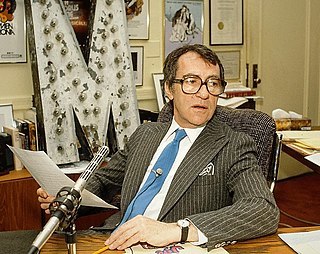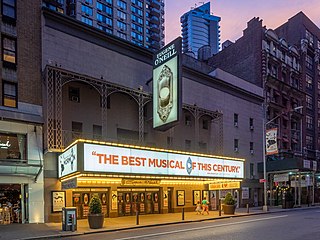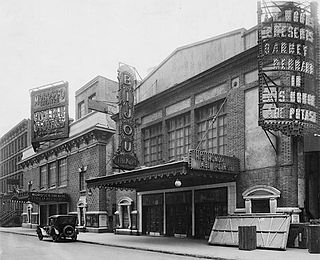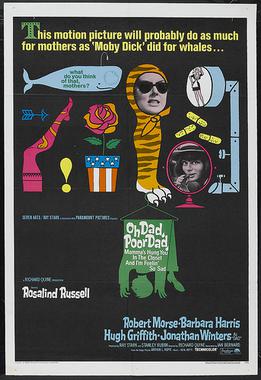
Joseph Papp was an American theatrical producer and director. He established The Public Theater in what had been the Astor Library Building in Lower Manhattan. There Papp created a year-round producing home to focus on new plays and musicals. Among numerous examples of these were the works of David Rabe, Ntozake Shange's For Colored Girls Who Have Considered Suicide When the Rainbow Is Enuf, Charles Gordone's No Place to Be Somebody, and Papp's production of Michael Bennett's Pulitzer Prize–winning musical A Chorus Line. Papp also founded Shakespeare in the Park, helped to develop other off-Broadway theatres and worked to preserve the historic Broadway Theatre District.

Jerome Robbins was an American dancer, choreographer, film director, theatre director and producer who worked in classical ballet, on stage, film, and television.

The Winter Garden Theatre is a Broadway theatre at 1634 Broadway in the Midtown Manhattan neighborhood of New York City. Originally designed by architect William Albert Swasey, it opened in 1911. The Winter Garden's current design dates to 1922, when it was completely remodeled by Herbert J. Krapp. Due to the size of its auditorium, stage, and backstage facilities, it is favored for large musical productions. It has 1,600 seats and is operated by The Shubert Organization. The auditorium interior is a New York City landmark.

Barbara Densmoor Harris was an American Tony Award-winning Broadway stage star and Academy Award-nominated motion picture actress.

The Shubert Theatre is a Broadway theater at 225 West 44th Street in the Theater District of Midtown Manhattan in New York City. Opened in 1913, the theater was designed by Henry Beaumont Herts in the Italian Renaissance style and was built for the Shubert brothers. Lee and J. J. Shubert had named the theater in memory of their brother Sam S. Shubert, who died in an accident several years before the theater's opening. It has 1,502 seats across three levels and is operated by The Shubert Organization. The facade and interior are New York City landmarks.

Arthur Lee Kopit was an American playwright. He was a two-time Pulitzer Prize finalist for Indians and Wings. He was also nominated for three Tony Awards: Best Play for Indians (1970) and Wings (1979), as well as Best Book of a Musical for Nine (1982). He won the Vernon Rice Award in 1962 for Oh Dad, Poor Dad, Mamma's Hung You in the Closet and I'm Feelin' So Sad and was nominated for another Drama Desk Award in 1979 for Wings.
Michael Wilson is an American stage and screen director working extensively on Broadway, Off-Broadway, and at the nation's leading resident theaters.

The Eugene O'Neill Theatre, previously the Forrest Theatre and the Coronet Theatre, is a Broadway theater at 230 West 49th Street in the Theater District of Midtown Manhattan in New York City. The theater was designed by Herbert J. Krapp and was constructed for the Shubert brothers. It opened in 1925 as part of a hotel and theater complex named after 19th-century tragedian Edwin Forrest. The modern theater, named in honor of American playwright Eugene O'Neill, has 1,108 seats across two levels and is operated by Jujamcyn Theaters. The auditorium interior is a New York City designated landmark.

The Broadhurst Theatre is a Broadway theater at 235 West 44th Street in the Theater District of Midtown Manhattan in New York City. Opened in 1917, the theater was designed by Herbert J. Krapp and was built for the Shubert brothers. The Broadhurst Theatre is named for British-American theatrical producer George Broadhurst, who leased the theater before its opening. It has 1,218 seats across two levels and is operated by The Shubert Organization. Both the facade and the auditorium interior are New York City landmarks.

The Booth Theatre is a Broadway theater at 222 West 45th Street in the Theater District of Midtown Manhattan in New York City. Opened in 1913, the theater was designed by Henry Beaumont Herts in the Italian Renaissance style and was built for the Shubert brothers. The venue was originally operated by Winthrop Ames, who named it for 19th-century American actor Edwin Booth. It has 800 seats across two levels and is operated by The Shubert Organization. The facade and parts of the interior are New York City landmarks.

Theatre Intime is an entirely student-run dramatic arts not-for-profit organization operating out of the Hamilton Murray Theater at Princeton University. Intime receives no direct support from the university, and is entirely acted, produced, directed, teched and managed by a board of students that is elected once a semester. "Students manage every aspect of Theatre Intime, from choosing the plays to setting the ticket prices."
Oh Dad, Poor Dad, Mamma's Hung You in the Closet and I'm Feelin' So Sad: A Pseudoclassical Tragifarce in a Bastard French Tradition was the first play written by Arthur Kopit.

The Bijou Theatre was a former Broadway theater in New York City that opened in 1917 and was demolished in 1982.
Peter Glenville was an English film and stage actor and director.
Theatre Calgary is theatre company in Calgary, Alberta, Canada, established as a professional company in 1968. The following is a chronological list of the productions that have been staged since its inception as Musicians and Actors Club (MAC) from 1964 to 1968, and Theatre Calgary from 1968 onwards.
Princeton Summer Theater was founded in 1968 by a group of Princeton University undergraduates under the name 'Summer Intime' as a high grade summer stock theater company.
Michael Rudman was an American theatre director.
The following timeline of twentieth-century theatre offers a year-by-year account of the performance and publication of notable works of drama and significant events in the history of theatre during the 20th century. Musical theatre works are excluded from the list below.

The Phoenix Theatre was a pioneering off-Broadway theatre in New York City, extant from 1953 to 1982. The Phoenix was founded by impresario Norris Houghton and T. Edward Hambleton. The project was a pioneering effort in the establishment of off-Broadway theatre. Houghton and Hambleton wanted a theatre away from Times Square, that would host a permanent company, abjure the star system, produce four or five plays a season for limited engagements, and with ticket prices much lower than on Broadway.

Oh Dad, Poor Dad, Mamma's Hung You in the Closet and I'm Feelin' So Sad is a 1967 American black comedy film directed by Richard Quine, based on the 1962 play Oh Dad, Poor Dad, Mamma's Hung You in the Closet and I'm Feelin' So Sad: A Pseudoclassical Tragifarce in a Bastard French Tradition by Arthur L. Kopit. The screenplay was written by Ian Bernard. The film stars Rosalind Russell, Robert Morse and Barbara Harris; Harris was the only main cast member who had also appeared in the original, Off-Broadway production of the play.















